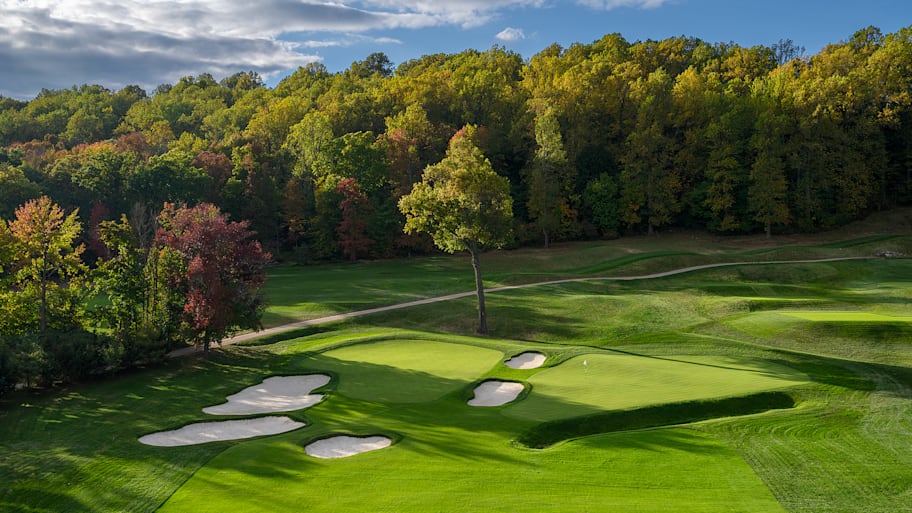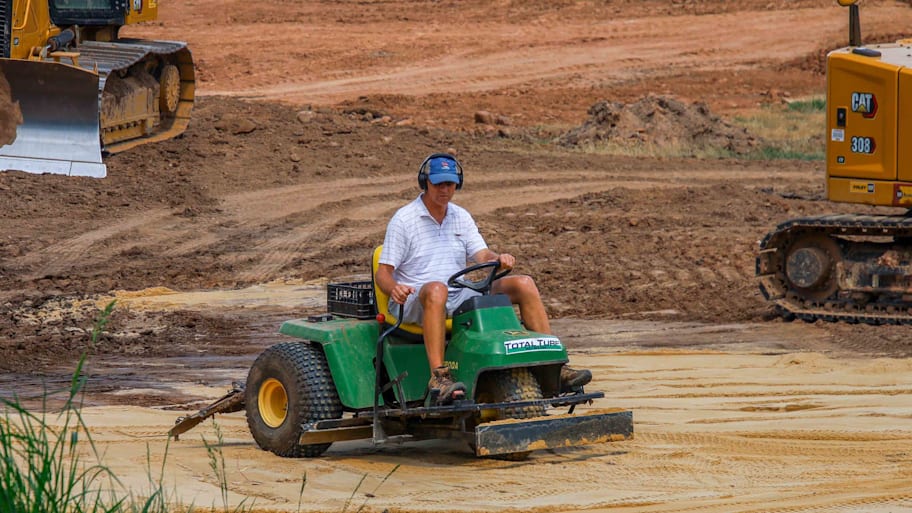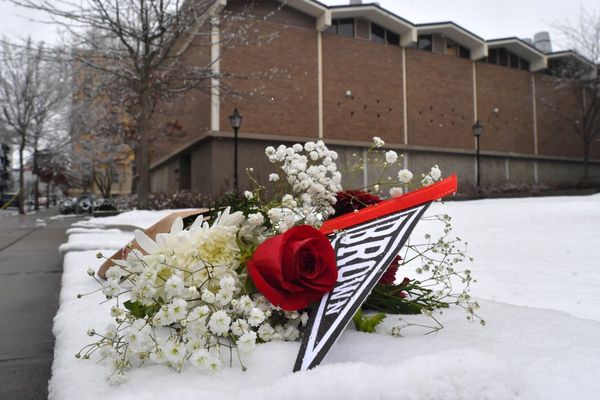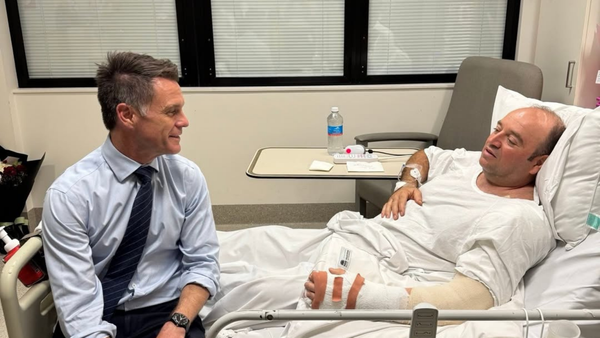
The 8th hole on the Upper course at the Baltusrol Golf Club is a 550-yard par-5 from the back tees. For the restoration of the A.W. Tillinghast design, which was unveiled this spring for members after a 12-month and $22.8 million construction, Gil Hanse used original drawings and photos to bring back the vision that Tillinghast had for the 8th hole when the Upper and Lower courses—commonly called "Dual Courses"—were opened in 1922.
“My favorite spot on the Upper is between the first two fairway bunkers on the 8th hole, looking at that green complex, how it sits up on the hill, how it serpentines around the fairway, and now with that beautiful American elm sitting up there by itself in all of its glory,” says Greg Boring, the 48-year-old director of grounds at Baltusrol. Boring is just the sixth person to hold that position in the 129-year history of the Springfield, N.J., club. “It’s one of the first places I go to when I bring someone out on the property. I bring them right to that spot. It’s hard to believe you’re less than 20 miles from one of the largest cities in the world when you’re out there. But it’s your own little piece of heaven.”
With the restoration of such venerable courses as Winged Foot (East and West courses), The Country Club, Southern Hills, the Yale Golf Course and Los Angeles Country Club, Hanse is synonymous with reviving the original intentions of some of the game’s greatest architects. The 61-year-old native of Babylon, N.Y., who started his own design firm in 1993 after earning a master’s degree in landscape architecture from Cornell and working with Tom Doak, is as much a historian and preservationist as he is an original designer, with his own roster of great courses.
Everywhere he goes, Hanse must be followed around by the ghosts of architects like Tillinghast, Donald Ross, Seth Raynor and C.B. Macdonald. With their drawings, writings, devotees and timeless layouts that continue to demand shotmaking and strategy from the world’s best players, these architects are his muses with new instructions for how to make their courses playable and sustainable for the game’s technological innovations.
But it’s not just a partnership between Hanse and these architects and the clubs that hire him to be faithful to these iconic original designs. In these restoration projects, superintendents like Boring are the key to the finished product and the preservation of the original architect’s vision.
“Once construction is over, it’s up to us to maintain the integrity of not only what Tillinghast has built, but what Gil restored,” Boring says.
In the Upper Course restoration and the preceding restoration of Baltustrol’s Lower Course, which was completed in 2021, Hanse and Boring demonstrated the essential bonds between architect and superintendent that are necessary for restorations of great courses. Even in the best of times, restorations are building projects that come up with many unexpected challenges, but overseeing the Lower restoration during the heart of the COVID-19 epidemic was especially difficult during a period of great uncertainty around the world. But according to Hanse, it was Boring who was instrumental in keeping the project on track.
“It could have gone sideways really easily, and it never did,” Hanse says. “I think that’s a testament to Greg’s patience and understanding and our experience and kind of helping guide everybody through what we were all dealing with through a pandemic, and some of the hiccups that go along with construction.”

It’s a trust between architect and superintendent borne out of the soil, nurtured by every careful decision from what trees to cut to the bunker shapings to how to treat the grasses to make the course play firm and fast. It’s an endlessly iterative process with often an uncompromising Mother Nature, budgets and the looming presence of a dead architect who was involved in the design of at least 265 courses.
One of Boring’s favorite stories about Hanse is during the restoration of the Lower Course when Larry Carpenter, a former multiple club champion, walked them through his memories of the original design of the 7th green complex before it was changed by Robert Trent Jones in the late 1940s. When the construction team did an excavation of the green complex, Carpenter’s recollections from the 1930s were spot on.
“It’s remarkable for Gil with his reputation in the industry to take that knowledge from Mr. Carpenter’s recollections, implement them during the excavation and archeological dig of the green, and uncover exactly what Tillinghast has put on the ground,” Boring says. “It was just a very cool part of the project, and something that I surely won’t forget anytime soon.”
Before Boring came to Baltusrol in 2019, he was the head superintendent for eight years at the Country Club of Scranton (Pa.), where he also served for a period as the general manager. Being a golf course superintendent is the only job that he says he’s ever wanted since he started working on a golf course when he was 14 years old.
In 1903, George Low, a Scottish-born pro, was hired as both Baltusrol’s first golf professional and greenskeeper during an era when it wasn’t uncommon for the pro to double as the greenskeeper. The Golf Course Superintendents Association of America (GCSAA) was founded in 1926 and now has nearly 20,000 members who are responsible for the playability of courses and advances in agronomics and turfgrass management around the world. And though golf course management is now a very respected career in the golf industry, it’s a role that’s often been in the shadow of the architects and the golf professionals.
“We’ve come a long way since the days of Carl Spackler and Caddyshack,” Boring says. “We have to be very visible now and be able to communicate with members at our clubs. And even in the 20 years that I’ve been a superintendent, my role has changed immensely, and I envision it’s going to continue to change for the next 20 to 30 years.”
For Hanse, recognition for Boring and other superintendents is long overdue. ”I believe that superintendents, or just maintenance workers in general, are the most underappreciated people in our business,” he says. “The emphasis placed on the architect versus the emphasis placed on the superintendent is historically out of whack.”
It would be difficult to discern that underappreciation of superintendents from the relationship between Hanse and Boring during the restoration of both the Lower and Upper courses at Baltusrol.
“One of the things that’s great about going through the entire process with a superintendent is that they’re there as well, building it and seeing it come to life,” Hanse says. “You know they have vested interest in seeing that it’s maintained in the fashion that we all hope it would be.”
Still as an architect-driven process, Hanse has the last word on important matters. Boring was initially unconvinced about Hanse’s desire to build a double green at the 14th hole during the Upper Course restoration.

“We've hired arguably the best golf course architect in the world today, and relied upon him to make these decisions,” Boring says. “Maybe at some point Gil did have conversations in his head with Tillinghast. But those two gentlemen made the decisions over the last five years to restore both of these properties and my hat's off to Gil and to this club leadership for allowing those things to happen.”
The detente over the 14th green is one of Hanse’s favorite memories of working with Boring. Hanse remembers the smirk on Boring’s face when he told him that they had finally reached a decision to build the double green after much guidance from an old photo of the green complex that showed two greens side by side.
“Sometimes we couldn't make up our minds out in the field, and that we were going to literally have to see it and feel it before we made up our minds,” Hanse says. “And Greg was O.K. with that, because he knew we were ultimately going to make the right decision. We may not get there right away, but we will ultimately get there. And he was willing and able and maybe even somewhat amused by being patient.”
This article was originally published on www.si.com as Baltusrol’s Upper Course Is Back to Original Vision Thanks to Gil Hanse-Led Partnership.







